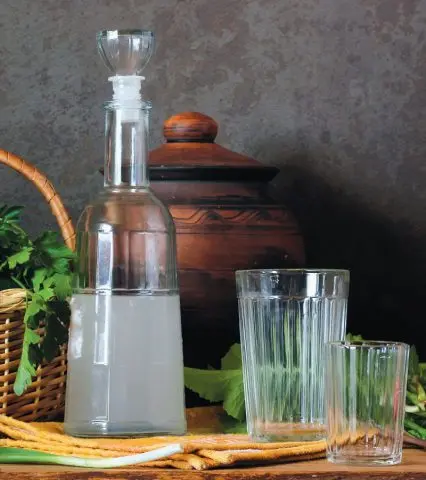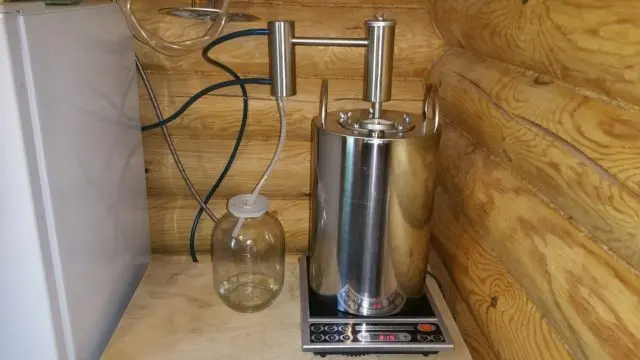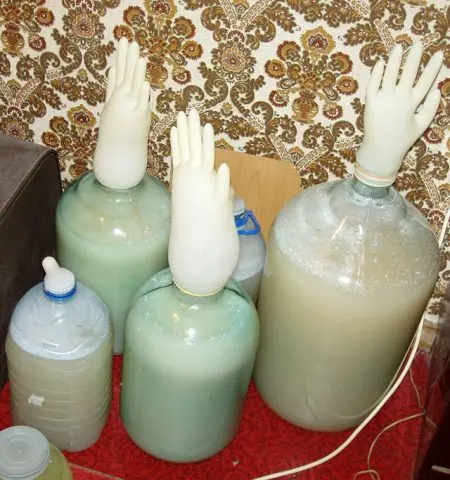Contents
To make high-quality moonshine from Jerusalem artichoke at home, you will have to try. The technology of preparing a drink requires care, strict adherence to proportions and a lot of time. But the resulting unique taste will make you forget about past difficulties.
The second name of Jerusalem artichoke is an earthen pear. This root crop is extremely unpretentious in cultivation and almost always gives an impressive harvest. Making homemade moonshine will solve the problem with the remains of Jerusalem artichoke, because to prepare 1 liter of the drink, about 10 kg of the plant will be required.

Secrets of making moonshine from Jerusalem artichoke
The finished drink has a refined apple flavor with hints of celery. Properly cooked, it will be soft, without sharp impurities. Fruits differ in size, juiciness, saturation. All these indicators must be taken into account in the process of preparing an alcoholic beverage.
Ingredients and their correct ratio are of great importance. Citric acid is added to stabilize the acidity. Sugar is optional, but it is often used to get more of the drink.
To obtain moonshine from Jerusalem artichoke with high organoleptic characteristics, high-quality moonshine stills are used. For the distillation of mash, it is recommended to look at models with a distillation column or a dry steamer.
When all the necessary ingredients are collected, you can start cooking. There are several recipes. The most successful is moonshine when using the classic recipe. To achieve a more refined taste, the root crop is fermented.
How to make moonshine from Jerusalem artichoke with yeast
The amount of ingredients needed depends on the juiciness of Jerusalem artichoke roots. This indicator is taken into account when calculating sugar and water for mash.
Ingredients:
- Jerusalem artichoke root – 10 kg;
- water – 5-10 l;
- citric acid – 5 g per liter of water;
- dry yeast – 25 g or 100 g pressed;
- sugar – 1-2 kg.
Braga preparation:
- Jerusalem artichoke is cleaned from the ground, washed, crushed with a grater.
- Pour the pulp into a large saucepan and pour 3-5 liters of water. The result is a liquid fleshy mass.
- Put the saucepan on the fire and bring to a boil. Then the fire is made smaller and boiled for 60-80 minutes. Periodically, the mass is mixed, carefully kneading the lumps. A sign of readiness will be a thick consistency of brew with a pleasant aroma of baked apples.
- After that, the mixture is allowed to cool to 30 degrees and poured into a fermentation tank. Add water – 2-3 liters, citric acid – 5 g for each liter of the finished liquid and sugar as desired. Be sure to leave 25% free volume in the tank for gases and foam.
- After that, yeast is prepared. The powder is dissolved in warm water and sugar is added. After the foam appears on the surface, they can be used. If pressed yeast is used, it is also dissolved. Leave for 15 minutes in a warm place, after which you can add to the mash. More detailed information is indicated on the packaging.
- Mix the whole slurry.
- Now they install a water seal or instead put a medical glove on the neck of the container with mash. A small hole must be made in it on the finger for the release of gases.
Such Jerusalem artichoke mash at home is infused for 3-10 days in a dark room with a temperature of 18-27 degrees. The signal for the start of the next stage is the absence of released gases from the hydraulic seal.

Filtration and distillation order:
- Braga is filtered through gauze. It is better to fold the cheesecloth several times in order to capture the pulp as much as possible.
- Liquid mash is poured into a distillation cube. The process is carried out without separation into fractions. As soon as the strength of the outgoing drink falls below 30%, the selection is stopped.
- The total strength of the drink is measured and the volume of absolute alcohol is calculated. To do this, the percentage of the fortress is multiplied by the volume and the resulting value is divided by 100.
- Then the liquid is diluted to 18-20% and the mash is re-distilled, but already with separation into fractions.
- The first 15% of absolute alcohol is collected in a separate container. This liquid is forbidden to eat, it is used exclusively for technical needs.
- The main product is collected in prepared containers. At this time, the strength of the drink is controlled and after it falls below 45% in the stream, the collection is stopped.
- At the final stage, moonshine is diluted with water to a strength of 40-45 degrees and sent to a dark place to brew.
It is better not to use the product immediately. After a few days, its taste indicators will noticeably improve. If moonshine is not planned to be consumed in the coming days, he needs to provide conditions for storage.
Village moonshine recipe from Jerusalem artichoke
To prepare such moonshine, the root crop undergoes preliminary fermentation. To taste, the prepared drink is very similar to tequila, so it can even be served on the festive table.
Ingredients:
- Jerusalem artichoke fruits – 10 kg;
- root tops – about 50 stems;
- water – 15 l;
- dry yeast – 10 g;
- sugar – 2 kg.
Fruit preparation:
- Dig a hole 70 cm deep and 1 m in diameter.
- Then lay bricks or large stones on the bottom.
- Firewood is laid on stones and bricks. They should be enough for 5-6 hours of burning. During this time, the base for heating will reach the desired temperature.
- After the firewood has burned down, spread the Jerusalem artichoke tops in a dense layer – 30-40 cm.
- Cooked tubers are evenly laid out on top of the greens.
- From above, Jerusalem artichoke must be covered with a layer of tops of 30-40 cm.
- In this state, the root crop with tops is kept for a day and allowed to cool.
Jerusalem artichoke has a smoked flavor and a golden crust. After that, proceed to the main part of the preparation of moonshine.

Braga preparation:
- Jerusalem artichoke is crushed and poured with water.
- Then heated to 50 degrees. Exceeding the temperature is unacceptable due to the chemical composition of the plant.
- The liquid with Jerusalem artichoke is simmered over medium heat for 2-3 hours.
- After the specified time, the mash is cooled naturally.
- After that, the mixture is filtered through gauze and sugar and yeast are added.
- Braga from Jerusalem artichoke, baked on a fire, comes in 1-2 days. If you keep more than the specified time, it will peroxide.
High-quality moonshine will come out only after 2 stages of distillation. It is important to let the prepared moonshine brew for 3-4 days, during which time it will reach the desired concentration and will please with its unusual taste.
How to store moonshine from Jerusalem artichoke
The prepared drink from Jerusalem artichoke is stored in plastic, glass and even wooden containers. The shelf life will depend on the material chosen. Containers are placed in a place protected from sunlight. Temperature fluctuations are also not recommended. Bottles can be put in the refrigerator, basement or closet.
To give moonshine additional woody notes, it is placed in oak barrels. This method is not only troublesome, but also unreliable. It is important to properly prepare the barrel, choose its volume. If you use a barrel without special preparation, the taste of the prepared liquid will change dramatically.
Often moonshine is poured into clean plastic bottles. To do this, choose those containers at the bottom of which are marked PET and PEHD / HDPE. It is a high quality plastic that does not react with liquids. The storage period should not exceed 4-6 months.
Glass containers remain the most reliable. In it, moonshine from Jerusalem artichoke retains its taste, aroma and does not change even for years. Tightly closing lids are essential. The liquid must not come into contact with air. Otherwise, the alcohol will evaporate, and the drink will lose its strength and even change its taste. Ideally, if the prepared moonshine is consumed within a year after the spill.
Conclusion
Moonshine from Jerusalem artichoke at home is a drink worthy of the attention of urban and rural residents. The listed recipes will not only solve the problem with the remains of the root crop, but also help create a drink that is unique in its taste and even healing properties.









